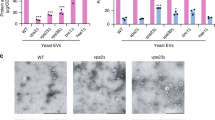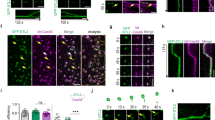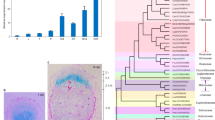Abstract
Fungal cells are surrounded by an extracellular cell wall. This complex matrix of proteins and polysaccharides protects against adverse stresses and determines the shape of fungal cells. The polysaccharides of the fungal wall include 1,3-β-glucan and chitin, which are synthesized by membrane-bound synthases at the growing cell tip. A hallmark of filamentous fungi is the class V chitin synthase, which carries a myosin-motor domain. In the corn smut fungus Ustilago maydis, the myosin-chitin synthase Mcs1 moves to the plasma membrane in secretory vesicles, being delivered by kinesin-1 and myosin-5. The myosin domain of Mcs1 enhances polar secretion by tethering vesicles at the site of exocytosis. It remains elusive, however, how other cell-wall-forming enzymes are delivered and how their activity is coordinated post secretion. Here, we show that the U. maydis class VII chitin synthase and 1,3-β-glucan synthase travel in Mcs1-containing vesicles, and that their apical secretion depends on Mcs1. Once in the plasma membrane, anchorage requires enzyme activity, which suggests co-synthesis of chitin and 1,3-β-glucan polysaccharides at sites of exocytosis. Thus, delivery of cell-wall-forming enzymes in Mcs1 vesicles ensures local foci of fungal cell wall formation.
This is a preview of subscription content, access via your institution
Access options
Subscribe to this journal
Receive 12 digital issues and online access to articles
$119.00 per year
only $9.92 per issue
Buy this article
- Purchase on Springer Link
- Instant access to full article PDF
Prices may be subject to local taxes which are calculated during checkout






Similar content being viewed by others
References
James, T. Y. et al. Reconstructing the early evolution of fungi using a six-gene phylogeny. Nature 443, 818–822 (2006).
Berbee, M. L. & Taylor, J. W. Dating the molecular clock in fungi—how close are we? Fungal Biol. Rev. 24, 1–16 (2010).
Blackwell, M. The fungi: 1, 2, 3 … 5.1 million species? Am. J. Bot. 98, 426–438 (2011).
Steinberg, G. Hyphal growth: a tale of motors, lipids, and the Spitzenkorper. Eukaryot. Cell 6, 351–360 (2007).
Hall, R. A. & Gow, N. A. Mannosylation in Candida albicans: role in cell wall function and immune recognition. Mol. Microbiol. 90, 1147–1161 (2013).
Mentlak, T. A. et al. Effector-mediated suppression of chitin-triggered immunity by Magnaporthe oryzae is necessary for rice blast disease. Plant Cell 24, 322–335 (2012).
Latge, J. P. The cell wall: a carbohydrate armour for the fungal cell. Mol. Microbiol. 66, 279–290 (2007).
Latge, J. P. Tasting the fungal cell wall. Cell. Microbiol. 12, 863–872 (2010).
Riquelme, M. & Sanchez-Leon, E. The Spitzenkorper: a choreographer of fungal growth and morphogenesis. Curr. Opin. Microbiol. 20, 27–33 (2014).
Miyazaki, A. & Ootaki, T. Multiple genes for chitin synthase in the zygomycete fungus Phycomyces blakesleeanus. J. Gen. Appl. Microbiol. 43, 333–340 (1997).
Weber, I., Assmann, D., Thines, E. & Steinberg, G. Polar localizing class V myosin chitin synthases are essential during early plant infection in the plant pathogenic fungus Ustilago maydis. Plant Cell 18, 225–242 (2006).
Kong, L. A. et al. Different chitin synthase genes are required for various developmental and plant infection processes in the rice blast fungus Magnaporthe oryzae. PLoS Pathog. 8, e1002526 (2012).
Pacheco-Arjona, J. R. & Ramirez-Prado, J. H. Large-scale phylogenetic classification of fungal chitin synthases and identification of a putative cell-wall metabolism gene cluster in Aspergillus genomes. PloS One 9, e104920 (2014).
Gandia, M., Harries, E. & Marcos, J. F. The myosin motor domain-containing chitin synthase PdChsVII is required for development, cell wall integrity and virulence in the citrus postharvest pathogen Penicillium digitatum. Fungal Genet. Biol. 67, 58–70 (2014).
Takeshita, N., Ohta, A. & Horiuchi, H. CsmA, a class V chitin synthase with a myosin motor-like domain, is localized through direct interaction with the actin cytoskeleton in Aspergillus nidulans. Mol. Biol. Cell 16, 01961–01970 (2005).
Tsuizaki, M., Takeshita, N., Ohta, A. & Horiuchi, H. Myosin motor-like domain of the class VI chitin synthase CsmB is essential to its functions in Aspergillus nidulans. Biosci. Biotechnol. Biochem. 73, 1163–1167 (2009).
Schuster, M. et al. Myosin-5, kinesin-1 and myosin-17 cooperate in secretion of fungal chitin synthase. EMBO J. 31, 214–227 (2012).
Martin-Urdiroz, M., Roncero, M. I., Gonzalez-Reyes, J. A. & Ruiz-Roldan, C. ChsVb, a class VII chitin synthase involved in septation, is critical for pathogenicity in Fusarium oxysporum. Eukaryot. Cell 7, 112–121 (2008).
Jimenez-Ortigosa, C. et al. Chitin synthases with a myosin motor-like domain control the resistance of Aspergillus fumigatus to echinocandins. Antimicrob. Agents Chemother. 56, 6121–6131 (2012).
Sanchez-Leon, E. et al. Traffic of chitin synthase 1 (CHS-1) to the Spitzenkörper and developing septa in hyphae of Neurospora crassa: actin dependence and evidence of distinct microvesicle populations. Eukaryot. Cell 10, 683–695 (2011).
Garcera-Teruel, A. et al. Loss of virulence in Ustilago maydis by Umchs6 gene disruption. Res. Microbiol. 155, 87–97 (2004).
Walker, J. E., Saraste, M., Runswick, M. J. & Gay, N. J. Distantly related sequences in the alpha- and beta-subunits of ATP synthase, myosin, kinases and other ATP-requiring enzymes and a common nucleotide binding fold. EMBO J. 1, 945–951 (1982).
Ambudkar, S. V., Kim, I. W., Xia, D. & Sauna, Z. E. The A-loop, a novel conserved aromatic acid subdomain upstream of the Walker A motif in ABC transporters, is critical for ATP binding. FEBS Lett. 580, 1049–1055 (2006).
Sasaki, N., Asukagawa, H., Yasuda, R., Hiratsuka, T. & Sutoh, K. Deletion of the myopathy loop of Dictyostelium myosin II and its impact on motor functions. J. Biol. Chem. 274, 37840–37844 (1999).
Schueler-Furman, O. & Baker, D. Conserved residue clustering and protein structure prediction. Proteins 52, 225–235 (2003).
Treitschke, S., Doehlemann, G., Schuster, M. & Steinberg, G. The myosin motor domain of fungal chitin synthase V is dispensable for vesicle motility but required for virulence of the maize pathogen Ustilago maydis. Plant Cell 22, 2476–2494 (2010).
Bottin, A., Kämper, J. & Kahmann, R. Isolation of a carbon source-regulated gene from Ustilago maydis. Mol. Gen. Genet. 253, 342–352 (1996).
Dichtl, K., Samantaray, S. & Wagener, J. Cell wall integrity signaling in human pathogenic fungi. Cell Microbiol. http://dx.doi.org/10.1111/cmi.12612 (2016).
Levin, D. E. Regulation of cell wall biogenesis in Saccharomyces cerevisiae: the cell wall integrity signaling pathway. Genetics 189, 1145–1175 (2011).
Munro, C. A. Chitin and glucan, the yin and yang of the fungal cell wall, implications for antifungal drug discovery and therapy. Adv. Appl. Microbiol. 83, 145–172 (2013).
Walworth, N. C. & Novick, P. J. Purification and characterization of constitutive secretory vesicles from yeast. J. Cell Biol. 105, 163–174 (1987).
Jena, B. P. Intracellular organelle dynamics at nm resolution. Methods Cell. Biol. 90, 19–37 (2008).
Takamori, S. et al. Molecular anatomy of a trafficking organelle. Cell 127, 831–846 (2006).
Schuster, M., Lipowsky, R., Assmann, M. A., Lenz, P. & Steinberg, G. Transient binding of dynein controls bidirectional long-range motility of early endosomes. Proc. Natl Acad. Sci. USA 108, 3618–3623 (2011).
Schuster, M. et al. Controlled and stochastic retention concentrates dynein at microtubule ends to keep endosomes on track. EMBO J. 30, 652–664 (2011).
Fuchs, U., Manns, I. & Steinberg, G. Microtubules are dispensable for the initial pathogenic development but required for long-distance hyphal growth in the corn smut fungus Ustilago maydis. Mol. Biol. Cell 16, 2746–2758 (2005).
Gaughran, J. P., Lai, M. H., Kirsch, D. R. & Silverman, S. J. Nikkomycin Z is a specific inhibitor of Saccharomyces cerevisiae chitin synthase isozyme Chs3 in vitro and in vivo. J. Bacteriol. 176, 5857–5860 (1994).
Bowman, J. C. et al. The antifungal echinocandin caspofungin acetate kills growing cells of Aspergillus fumigatus in vitro. Antimicrob. Agents Chemother. 46, 3001–3012 (2002).
Verdin, J., Bartnicki-Garcia, S. & Riquelme, M. Functional stratification of the Spitzenkorper of Neurospora crassa. Mol. Microbiol. 74, 1044–1053 (2009).
Sanchez-Leon, E. & Riquelme, M. Live imaging of β-1,3-glucan synthase FKS-1 in Neurospora crassa hyphae. Fungal Genet. Biol. 82, 104–107 (2015).
Fajardo-Somera, R. A. et al. Dissecting the function of the different chitin synthases in vegetative growth and sexual development in Neurospora crassa. Fungal Genet. Biol. 75, 30–45 (2015).
Collinge, A. J. & Trinci, A. P. Hyphal tips of wild-type and spreading colonial mutants of Neurospora crassa. Arch. Microbiol. 99, 353–368 (1974).
James, T. Y. & Berbee, M. L. No jacket required—new fungal lineage defies dress code: recently described zoosporic fungi lack a cell wall during trophic phase. BioEssays 34, 94–102 (2012).
James, T. Y. et al. Shared signatures of parasitism and phylogenomics unite cryptomycota and microsporidia. Curr. Biol. 23, 1548–1553 (2013).
Takeshita, N., Yamashita, S., Ohta, A. & Horiuchi, H. Aspergillus nidulans class V and VI chitin synthases CsmA and CsmB, each with a myosin motor-like domain, perform compensatory functions that are essential for hyphal tip growth. Mol. Microbiol. 59, 1380–1394 (2006).
Tsuizaki, M., Ohta, A. & Horiuchi, H. Myosin motor-like domain of class VI chitin synthase CsmB of Aspergillus nidulans is not functionally equivalent to that of class V chitin synthase CsmA. Biosci. Biotechnol. Biochem. 77, 369–374 (2013).
Takeshita, N. et al. Transportation of Aspergillus nidulans class III and V chitin synthases to the hyphal tips depends on conventional kinesin. PloS One 10, e0125937 (2015).
Brachmann, A., Weinzierl, G., Kamper, J. & Kahmann, R. Identification of genes in the bW/bE regulatory cascade in Ustilago maydis. Mol. Microbiol. 42, 1047–1063 (2001).
Theisen, U., Straube, A. & Steinberg, G. Dynamic rearrangement of nucleoporins during fungal ‘open’ mitosis. Mol. Biol. Cell 19, 1230–1240 (2008).
Bölker, M., Genin, S., Lehmler, C. & Kahmann, R. Genetic regulation of mating and dimorphism in Ustilago maydis. Can. J. Bot. 73, 320–325 (1995).
Steinberg, G. & Schuster, M. The dynamic fungal cell. Fungal Biol. Rev. 25, 14–37 (2011).
Kilaru, S. & Steinberg, G. Yeast recombination-based cloning as an efficient way of constructing vectors for Zymoseptoria tritici. Fungal Genet. Biol. 79, 76–83 (2015).
Higuchi, Y., Ashwin, P., Roger, Y. & Steinberg, G. Early endosome motility spatially organizes polysome distribution. J. Cell Biol. 204, 343–357 (2014).
Holliday, R. in Ustilago maydis (ed. King, R. C. ) 575–595 (Plenum Press, 1974).
Schulz, B. et al. The b alleles of U. maydis, whose combinations program pathogenic development, code for polypeptides containing a homeodomain-related motif. Cell 60, 295–306 (1990).
Steinberg, G. et al. Motor-driven motility of fungal nuclear pores organizes chromosomes and fosters nucleocytoplasmic transport. J. Cell Biol. 198, 343–355 (2012).
Wedlich-Söldner, R., Bölker, M., Kahmann, R. & Steinberg, G. A putative endosomal t-SNARE links exo- and endocytosis in the phytopathogenic fungus Ustilago maydis. EMBO J. 19, 1974–1986 (2000).
Tamura, K. et al. MEGA5: molecular evolutionary genetics analysis using maximum likelihood, evolutionary distance, and maximum parsimony methods. Mol. Biol. Evol. 28, 2731–2739 (2011).
Acknowledgements
The authors thank U. Fuchs, S. Milne and P. Splatt for technical support. M.M.-U. thanks N.J. Talbot for financial support. G.S. acknowledges J. Stajich for fruitful discussions. This work was supported by the Biotechnology & Biological Sciences Research Council (grants BB/H019774/1 and BB/I020667/1 to G.S.).
Author information
Authors and Affiliations
Contributions
G.S. developed the research plan and the experimental strategy, directed the project, analysed data, assembled all figures and videos and wrote the manuscript (with the exception of the Methods, which was written mainly by M.M.-U., M.S. and C.H.). M.M.-U. generated strains and plasmids, performed experiments and analysed data. M.S. performed experiments, generated strains and analysed data. Y.H. and S.K. generated strains and plasmids. C.H. performed electron microscopy. S.J.G. discussed the project and data. All authors corrected the manuscript and discussed data.
Corresponding author
Ethics declarations
Competing interests
The authors declare no competing financial interests.
Supplementary information
Supplementary Information
Supplementary Figures 1-6 (Colour-adjusted main figures for readers with red-green colour blindness), Supplementary Figures 7-16, Supplementary Tables 1-3, Supplementary References (PDF 3612 kb)
Supplementary Video 1
Motility of Chs6-GFP3 in U. Maydis. (MOV 429 kb)
Supplementary Video 2
Motility of Mcs1-GFP3 and Chs6-GFP3 in a yeast-like cell of U. maydis. (MOV 417 kb)
Supplementary Video 3
Co-motility of mCherry3-Mcs1 and Chs6-GFP3 in a yeast-like cell of U. maydis. (MOV 127 kb)
Supplementary Video 4
Co-motility of mCherry3-Mcs1 and GFP3-Gsc1 in a yeast-like cell of U. maydis. (MOV 226 kb)
Supplementary Video 5
Diffusive motion of Mcs1-GFP3 in control cells, cell wall-less protoplasts and in the presence of the CHS inhibitor nikkomycin Z and the GS inhibitor caspofungin. (MOV 448 kb)
Supplementary Video 6
Co-motility of mCherry3-Mcs1 and GFP3-Gsc1 in a hyphal cell of U. maydis. (MOV 251 kb)
Rights and permissions
About this article
Cite this article
Schuster, M., Martin-Urdiroz, M., Higuchi, Y. et al. Co-delivery of cell-wall-forming enzymes in the same vesicle for coordinated fungal cell wall formation. Nat Microbiol 1, 16149 (2016). https://doi.org/10.1038/nmicrobiol.2016.149
Received:
Accepted:
Published:
DOI: https://doi.org/10.1038/nmicrobiol.2016.149
This article is cited by
-
Chitin synthases containing myosin motor-like domain are required for cell wall integrity and virulence of vascular wilt pathogen Verticillium dahliae
Phytopathology Research (2023)
-
Regression modelling of conditional morphogene expression links and quantifies the impact of growth rate, fitness and macromorphology with protein secretion in Aspergillus niger
Biotechnology for Biofuels and Bioproducts (2023)
-
Architecture of the dynamic fungal cell wall
Nature Reviews Microbiology (2023)
-
Arbuscular mycorrhiza and soil organic nitrogen: network of players and interactions
Chemical and Biological Technologies in Agriculture (2019)
-
Comparative genomics reveals the origin of fungal hyphae and multicellularity
Nature Communications (2019)



